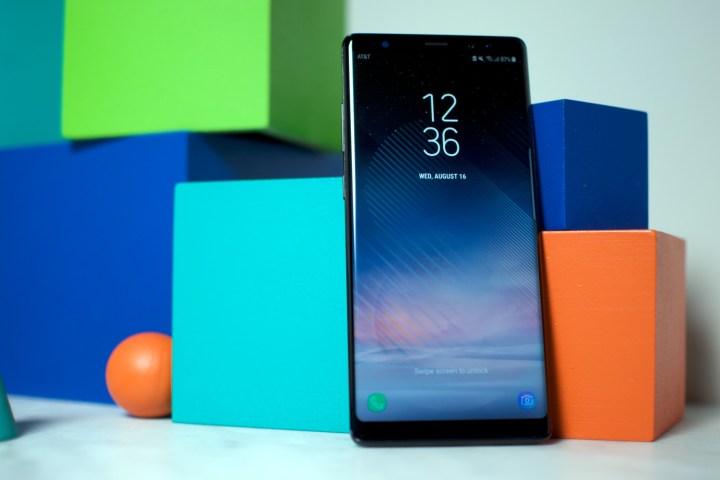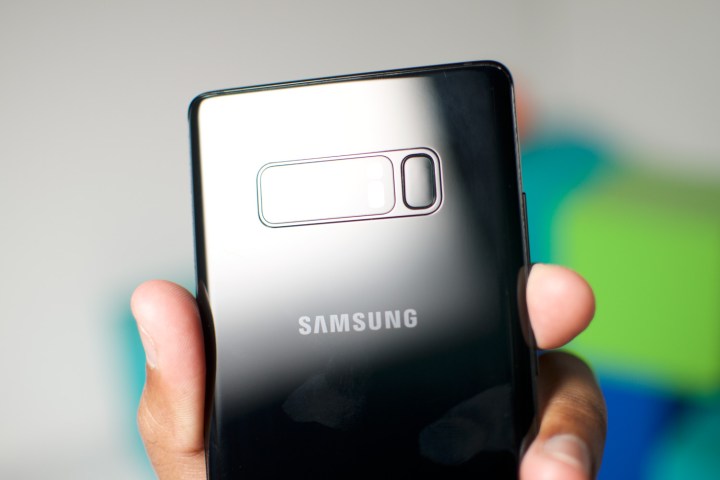
The Note 8 goes up against some serious competition. Setting aside the other top-tier Android phones currently available, there’s also the Apple iPhone 7 Plus, which is the best iOS phone currently available. So how does the new Samsung Galaxy Note 8 compare with the iPhone 7 Plus? Below, we pitted the two against one another to find out.
Specs
| Samsung Galaxy Note 8 | iPhone 7 Plus
|
|
| Size | 162.5 x 74.8 x 8.6 mm (6.40 x 2.95 x 0.34 inches) | 158.2 x 77.9 x 7.3 mm (6.23 x 3.07 x 0.29 inches) |
| Weight | 6.88 ounces (195 grams) | 6.63 ounces (188 grams) |
| Screen | 6.3-inch Super AMOLED | 5.5-inch LCD |
| Resolution | 2,960 x 1,440 (522 ppi) | 1,920 x 1,080 pixels (401 ppi) |
| OS | Android 7.1.1 Nougat | iOS 10 |
| Storage | 64GB (U.S.) 128, 256GB (International) | 32, 128, 256GB |
| MicroSD card slot | Yes | No |
| NFC support | Yes | Yes (Apple Pay only) |
| Processor | Qualcomm Snapdragon 835, Samsung Exynos 8895 (international) | A10 Fusion with 64-bit architecture, M10 motion coprocessor |
| RAM | 6GB | 3GB |
| Connectivity | GSM, CDMA, HSPA, EVDO, LTE | 4G LTE, GSM, CDMA, HSPA+, 802.11a/b/g/n/ac Wi-Fi |
| Camera | Dual 12 MP rear both with OIS, 8MP front | Dual 12MP rear one with OIS, 7MP front |
| Video | 4K | 4K at 30fps, 1080p at 30 or 60fps |
| Bluetooth | Yes, version 5.0 | Yes, version 4.2 |
| Fingerprint sensor | Yes | Touch ID |
| Other sensors | Accelerometer, barometer, gyro, geomagnetic, heart rate, proximity, iris, pressure | Barometer, 3-axis gyro, accelerometer, proximity sensor, ambient light sensor |
| Water resistant | Yes, IP68 rated | Yes, IP67 rated |
| Battery | 3,300mAh | 2,900mAh |
| Charging port | USB-C | Lightning |
| Marketplace | Google Play Store | Apple App Store |
| Colors | Midnight Black, Orchid Gray | Gold, rose gold, silver, black, jet black |
| Availability | AT&T, Verizon, Sprint, T-Mobile, Unlocked | AT&T, Verizon, Sprint, T-Mobile, Unlocked |
| Price | $930 | $729 |
| DT review | Hands-on | 4 out of 5 stars |
You might think the Samsung Galaxy Note 8 mops the floor with the Apple iPhone 7 Plus, but that may not necessarily be the case. The iPhone 7 Plus features Apple’s A10 Fusion chip, which has proven to be a formidable opponent for Qualcomm’s processors — so much so that the A10 Fusion has consistently beaten out the Snapdragon 835 in benchmarks, especially when it comes to single-core tests. That’s no different in this phone. Even though the Samsung Galaxy Note 8 boasts a hefty 6GB of RAM, the iPhone 7 Plus, with only 3GB of RAM, has still consistently beaten other Android phones with 6GB or even 8GB of RAM.
Of course, benchmarks are only one indicator of performance — what’s really important is real-world use. Thankfully, both phones will prove to be nice and smooth in almost all use-cases, and will continue to do so for at least the next few years.
When it comes to storage, in the U.S. the iPhone offers more options. The Galaxy Note 8 comes with 64GB of internal storage, but there’s a MicroSD card slot so you can upgrade your space if needed. The international model comes with 128GB and 256GB options. While the base storage option on the iPhone 7 Plus comes is 32GB, it does not have a MicroSD card slot. If you need more space, you can look to the 128GB or 256GB options.
Still, it’s hard to look past the raw performance on the iPhone — that makes it the winner here.
Winner: Apple iPhone 7 Plus
Design, display, and durability

The Samsung Galaxy Note 8 features a similar design as the Galaxy S8 before it — but it’s a little bigger. The device features a massive, 6.3-inch display, which is bigger than most and is largely owed to how the display covers such a large portion of the front of the phone. The iPhone is also a beautiful device, but it’s not as unique as the Samsung Galaxy Note 8.
When it comes to the display, the iPhone 7 Plus offers a 5.5-inch LCD display with 1,920 x 1,080-pixel resolution. The Samsung Galaxy Note 8 really steps things up with a 6.3-inch Super AMOLED display, one outfitted with 2,960 x 1,440-pixel resolution. That puts the device well ahead of the iPhone 7 Plus in the display department.
The Galaxy Note 8 is also arguably more durable. While the iPhone 7 Plus offers IP67 waterproofing — which allows it to withstand up to a meter of water for up to 30 minutes — the Galaxy Note 8 features an IP68 rating. This allows the Galaxy Note 8 to withstand up to 1.5 meters of water for 30 minutes. You shouldn’t take either of these two devices swimming, but if you happen to drop them in the pool or bath, they should be alright. Durability also means drops, though, and considering the iPhone doesn’t have a display that wraps around its edges or glass on both sides, we think it will likely perform better with accidental drops.
Because the Galaxy Note 8 has better waterproofing, a better display, and a more unique design, we’re giving this one to Samsung.
Winner: Samsung Galaxy Note 8
Battery life and charging

The Samsung Galaxy Note 8 has a larger battery than the iPhone 7 Plus, coming in at 3,300mAh versus the iPhone’s 2,900mAh battery. This doesn’t necessarily translate to longer battery life, especially given the more-intensive display on the Galaxy Note 8. Still, it is a significant boost and while we’ll have to wait and see how long the battery lasts, for now the bigger capacity puts the Samsung phone ahead.
The Galaxy Note 8 also offers better charging capabilities. While the iPhone 7 Plus doesn’t really offer anything in the way of quick charging, the Galaxy Note 8 offers Adaptive Fast Charging, which lets you charge the device 50 percent in 30 minutes. That’s pretty huge — so even if the battery life on the device does end up being a little shorter, you’ll be able to charge it significantly quicker. Not only that, but the Galaxy Note 8 also has wireless charging, something that Apple has traditionally shunned — although that may change with the release of the iPhone 8.
Winner: Samsung Galaxy Note 8
Camera

The iPhone has traditionally been a leader in the camera department, but lately other manufacturers have been putting a lot more focus on their cameras. The result is excellent cameras on most flagship smartphones. Both the Note 8 and the iPhone 7 Plus offer a dual 12MP camera on the rear, with one telephoto lens and one wide-angle lens. For the Galaxy Note 8, both camera lenses feature optical image stabilization, which means photos taken at 2x optical zoom or higher are less likely to be blurry.
Samsung has a Live Focus feature on the Note 8, which is similar to the iPhone 7 Plus’ Portrait Mode. Focus on a subject and you can blur the background before and after you take a photo. Dual capture mode also takes a photo with each lens, so you get a wide-angle shot and a zoomed in one as well.
The iPhone’s camera was also pretty well-received, offering optical image stabilization on one lens. The Note 8’s features seem to take things a step further, but we’ll have to test it out to see how it fares. For now, it’s a close tie.
Winner: Tie
Software

Spoiler alert: We’re not going to award a winner here. But we will note a few key differences between the software on these two phones. The iPhone, which runs Apple’s iOS, has long been known to offer an extremely simple and easy user experience, and for good reason. The operating system is built for simplicity, so if you’re looking for an operating system that “just works,” then look no further. Android, on the other hand, is known to offer better customization, so if customization is important to you, then the Galaxy Note 8 might be better.
Keep in mind the Note 8 comes with the S Pen, a stylus with special nifty features like instant translation, writing notes on the always-on display, and more. If stylus features like these are important to you, go for the Note 8.
Winner: Tie
Price and availability
The iPhone 7 Plus has been available for some time now, and you can get it from Apple unlocked, or from any major carrier. It starts at $769, which is a lot of money, but not insane for today’s phablet-sized devices.
What is somewhat insane is the price of the Galaxy Note 8, which costs anywhere from $930 and $960, depending on who you get it from. That’s a lot of cash. The Galaxy Note 8 is available for pre-order as of August 24, and for purchase outright starting September 15. It’ll be available from Samsung, Best Buy, Amazon, and all major carriers.
Considering how much cheaper the iPhone 7 Plus is, it’s the clear winner here.
Winner: Apple iPhone 7 Plus
Overall winner: Tie
So, which device should you buy? This may end up being a classic case of iOS vs. Android, meaning it largely depends which operating system you’re plugged into. If, however, you have no platform preference, then the Galaxy Note 8 is newer — but it comes at a serious price. The iPhone, on the other hand, is around $200 cheaper, and it’s a slightly better performer. Of course, you really can’t go wrong either way here — no matter which phone you buy, you’re getting a premium device that should last for at least a few years.
If you want the cutting edge and don’t mind paying for it, the Galaxy Note 8 is the phone to get. If, however, you just want a reliable and easy-to-use device and wouldn’t mind saving some money, then the iPhone might be a better option.





